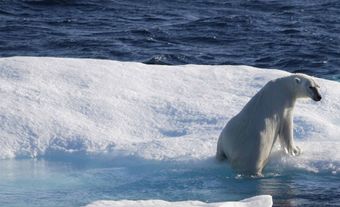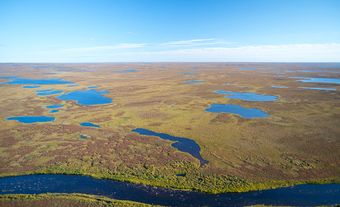Nunavut — meaning "our land" in the Inuit language Inuktitut — entered Confederation in 1999 as Canada's third territory and newest member of the country.
Arctic Lands Acquired by Canada
People first populated the land of Nunavut about 5,000 years ago, when the Tuniit crossed the Bering Strait land bridge from Russia. About 1,000 years ago, the Thule moved into the area and displaced the Tuniit. The Thule, later called Inuit, left the High Arctic about 500 years ago and hunted caribou and seal further south.
At the time of Confederation in 1867, what is now Nunavut lay within Rupert's Land and the North-Western Territory, each under the control of the Hudson's Bay Company. Canada bought the vast territories from the HBC in 1870 and administered the area in the renamed North-West Territories. About 150,000 Indigenous people lived there.
In 1880, Canada obtained the Arctic islands from Britain, increasing the size of the territory.
The North-West Territories became progressively smaller as existing provinces expanded their boundaries northwards and new provinces and territories were created (Yukon in 1898, and Alberta and Saskatchewan in 1905).
Eastern and Western Arctic
In the 1930s, the Inuit suffered an economic setback when the fur market collapsed. The Canadian government made Inuit wards of the state in the 1940s and moved Inuit into more centralized villages in the 1950s.
Between 1959 and 1963, the territorial council discussed dividing the Northwest Territories (NWT) into eastern and western halves so that the more populous western half could economically develop at a quicker pace. The Inuit, most of whom lived in the eastern half of the territory, were not consulted on this proposal. The idea died when the federal Parliament dissolved in 1963.
In 1966, the Carrothers Commission concluded that the NWT should indeed be divided, but recommended delaying action for 10 years.
Nunavut Land Claim
In 1967, Yellowknife (located in the western half of the NWT) was declared capital of the territory — the new home of its government and civil service. Although government had now moved north from Ottawa, many people in the eastern Arctic felt Yellowknife was still too far for their concerns to be heard. In 1979, Inuit leaders ran as candidates in territorial elections, and many were elected.
With Inuit politicians now pushing for change, the new territorial government studied ideas for dividing the NWT into two territories. By this time the Inuit Tapirisat of Canada, an Inuit advocacy group, had proposed the creation of the separate territory of Nunavut as part of a legal settlement of Inuit land claims in the NWT.
In 1982, the Tungavik Federation of Nunavut was established to represent the Inuit of the eastern Arctic and negotiate a land claim agreement with the federal government. In an NWT-wide plebiscite that same year, 56 per cent of voters supported dividing the eastern and western halves of the territory. About 80 per cent of voters in the eastern side supported the idea.Supporters believed a new territory would allow Inuit to have more control over their own lives and land.
After a decade of discussions, the Nunavut Land Claims Agreement was reached in 1992. It gave the Inuit of the eastern Arctic, through the Tungavik Federation of Nunavut, greater rights over lands and resources, as well as cash compensation for other areas that were to remain Crown lands and a federal commitment to create a new territory.
In another NWT-wide plebiscite, in 1992, more than 54 per cent of voters backed the proposed boundary to divide the NWT. The Nunavut Act, creating the new territory, was adopted by Parliament in 1993.
Nunavut Enters Confederation
Over the next six years a federally appointed commission, led by Inuit leader and Chief Commissioner John Amagoalik, worked to establish government institutions, including a civil service, for the new territory. In 1999, the people of Nunavut elected their first 19-member assembly, which named Paul Okalik as premier. Helen Maksagak became the first commissioner.
On 1 April 1999, Nunavut officially became Canada’s newest territory, with Iqaluit as its capital.

 Share on Facebook
Share on Facebook Share on X
Share on X Share by Email
Share by Email Share on Google Classroom
Share on Google Classroom






